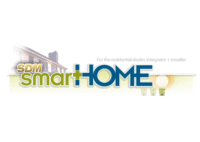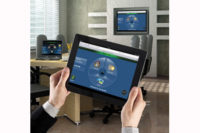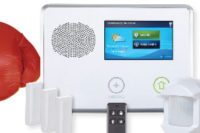
The hard realities of the current recession are hitting every facet of the economy, and the home automation industry is no exception. With the housing market slump and new construction down dramatically, new installation projects for home automation, security, and entertainment systems are few and far between. Facing the financial uncertainties of this economy, homeowners are becoming increasingly cost-conscious and more focused on meeting specific needs as they reevaluate their spending priorities.
“The first word out of everybody’s mouth is budget. Budget, budget, budget,” says Scott Hoxter, owner of Protection Plus Inc., located in Boynton Beach, Fla.
Even though new customers are harder to come by and existing clients are proceeding with caution, smart home integrators are finding that the news is not all bad. In fact, by identifying emerging trends, they are finding new ways to foster business and increase revenue. Even a bad economy can be good for business in some areas.
Mark Matlock, senior vice president of sales and marketing for United Central Control Inc. of San Antonio, Texas, understands that the uncertainty of the stalled economy is on the minds of business people and their customers.
“Nobody knows when this ship is going to sail — it’s a little scary,” he emphasizes. But as difficult as the times may be, areas for potential growth still exist. Matlock notes that security tends to be a more recession-resistant business than most: “Unfortunately, in a bad economy, security is a big issue.”
By adapting to their customers’ demands for security and comfort, integrators can create value for existing customers. With the housing market nearly at a standstill in many areas of the country, homeowners are staying put. Some of them are taking the opportunity to make improvements to their current homes. Integrators can provide them with comfort and value in home automation, security, and entertainment systems. In this economic storm, smart residential contractors and dealers are riding the smooth undercurrents of developing demand. Along with a nesting trend, increasingly tech-savvy customers are seeking new products and features that bring the benefits of their systems to their fingertips. Likewise, the availability of new technologies at affordable prices is allowing these customers to find ways to implement their desires to create greener lifestyles.
There’s No Place Like Home
With no uptick in the market for the foreseeable future, homeowners are hunkering down. “There’s a bit of a nesting phenomenon going on,” observes Duane Paulson, president of Sequel Technologies Inc., St. Paul, Minn.
Paulson is finding that the vast majority of business is coming from retrofits, rather than new installations. Rather than looking to move up to a new home, people are putting money into their existing homes to make life more convenient and comfortable. They want to preserve value and protect their homes and families. Paulson says that security is the predominant area of interest for homeowners.
Scott Hoxter would agree. “Crime is definitely up. A lot of people on the residential side want to do whatever they can to protect their homes,” he says. Homeowners are investing in lighting controls and cameras to enhance the security of their homes, and they are looking for cost-effective, plug-and-play products, Hoxter describes. One of the most popular security features right now is pre-event video with notification. When the security alarm is triggered, the system immediately notifies the homeowner via an e-mail or text message to cell phones, PDAs, BlackBerry and other devices. The e-mail not only notifies the owner of the alarm, but also includes a 35-second video clip (5 seconds before and 30 seconds after the triggering event), allowing the homeowner to determine whether there is a legitimate security threat or an accidental activation.
While most people use security systems to keep unwanted people out of a home, many customers are finding them to be useful for ensuring that some people get in. Hoxter and others in the industry note that working parents especially like the remote notification features; it lets them know that their children have arrived home safely, providing peace of mind – even when the children forget to call. “It’s something they can afford, and it’s not really expensive,” Hoxter says.
In addition to security concerns, the economy is affecting how people choose to spend their money. Cost-conscious consumers are spending more time at home, cutting back on everything from vacations to dining out. Because of this, many want to improve their surroundings. Customers with the means are interested in audio-video systems, not only for entertainment, but also as part of home design.
“They don’t look at it as the purchase of a TV, but as an overall change in the room environment. It can change the feel and flow of the entire room,” says Michael Wilson, owner of Bethesda Systems in Washington, D.C.
He notes that replacing conventional sets with flat-panel televisions can really open up a room, leading customers to think of their entertainment systems as part of the room design. Similarly, newer technologies enable homeowners to clean up the eclectic jumble of electronics housed in large entertainment centers. “People are finally finding cost-effective ways to store and hide equipment, and they realize it provides a nice, clean look,” Wilson adds.
Technophiles Lead the Way
While aesthetic concerns may be a driving force for some homeowners, others are more interested in the available technology. Centralized entertainment systems not only change the look and feel of their surroundings, but they also provide customers with the opportunity to use their favorite portable devices in the home. “People look for anything to do with the word iPod. They are looking for any way to dock or interface with the iPod,” Wilson observes.
While it is no secret that convenience is one of the most appealing benefits of electronics, as more and more people are becoming comfortable with technology through the use of iPods, cell phones, BlackBerry devices, and more, their interest in adding technology to the home has piqued. “People are becoming more technically savvy. They are used to being in interface with technology,” Paulson says. He believes that the increasing technological literacy of customers is driving demand. “People are becoming more sophisticated with what they want to do in the home,” he says.
Most industry professionals agree that customers are increasingly looking for remote access of their electronic systems. Whether they are setting lighting and environmental controls from a laptop, accessing video online, or receiving security alerts sent to a PDA, more and more homeowners desire the convenience and reassurance that remote access to automation provides. “That interactivity expectation is higher,” Paulson notes.
Beyond conventional purposes, some customers are finding creative uses for this technology, making it a must-have. Combining video with remote access offers some interesting possibilities. Mark Matlock of United Central Control offers the example of a soldier fighting in Iraq who is able to log in and join a family birthday party. “It’s things like that, that have a lot of appeal, a lot of sizzle,” Matlock believes. He says customers are looking for systems that offer flexibility and affordability. While they are not looking for high-end luxury items, many are still interested in technology that is not just useful, but fun. “Video is an affordable toy. It’s a security device, but it’s a really neat toy,” says Matlock.
Jim Gist, vice president of global hospitality for Control 4 Inc., reports that customers are currently interested in products that are priced competitively, but offer modularity to provide for future upgrades. He explains that the modular, standards-based systems offered by his company are “like digital Legos,” allowing homeowners to buy now and add on later to enhance the system. He has also noticed an interesting customer trend: “People who are in the mindset of technology are typically green-minded and say, ‘what else can I do for the planet?’”
Automation Goes Green
Gist is not alone in his observations; the trend towards green options in home automation is widespread. Duane Paulson agrees. He sees homeowners looking for ways to save money on energy costs and reduce their impact on the environment. With a multitude of affordable technologies available, going green is becoming increasingly attractive for homeowners. Paulson welcomes the trend, “It’s one of those things that’s time finally may have come.”
He says the focus is not necessarily on complex systems; customers are looking for simple green solutions in automation. By simply automating environmental and lighting controls to turn down the thermostat when the home is unoccupied or to dim the lights in specific areas, homeowners can reduce energy consumption and costs.
“People are more cognizant of their impact on the environment and security,” says Jay McLellan, president of Home Automation Inc. (HAI), New Orleans. “They see the common sense of tying energy conservation with security systems.”
Although the economy may be slow, emerging trends in home automation provide opportunity for residential contractors to grow new business. Meeting customer needs and wants through increased diversification and flexibility will help home integrators remain competitive and discover lucrative, new opportunities. As customer demand moves towards convenient remote access and increased automation to build greener lifestyles, new technologies and creative solutions become more important. Integrators that can target customer needs with products and services at affordable prices, while providing enhanced functionality and the option of future expansion, will not only survive, but thrive in these rocky times.
SIDEBAR: Whole-Home Audio: Finding Its Rhythm
A new report produced in January by Forrester Research Inc., Cambridge, Mass., “How Whole-Home Audio Products Can Find Their Rhythm,” puts forth the idea that whole-home audio is currently achieved through a “patchwork of solutions,” and further, that consumers really do want to play music in multiple rooms, but they prefer relatively simple and cheap solutions for doing so.
The Forrester report defines whole-home audio as “the ability to deliver audio into many rooms of the house from a central media source connected to the Internet,” and that it “is an experience that has traditionally been the purview of the home installation market and its affluent customers.”
“Today, 61 percent of U.S. households have a broadband connection and 28 percent of them have a home network, providing them with not only a fat pipe for real-time media delivery but also the means to share this media across the rooms of their home. They just need a convenient way to use that home network to satisfy their whole-home audio urges,” the study acknowledged.
To learn more about this research, visit www.forrester.com.
SIDEBAR: Sound Strategies
Many residential dealers and manufacturers report that a focus on fundamental business strategies is more important than ever in difficult economic times:- Return to your customer base. With residential construction down, new customers are hard to find. Your existing client base is a great place to find new opportunities. Working with existing clients has many advantages: they already know the value of the products and systems, they trust you, and they are prequalified.
- “Find creative ways to remarket to existing clients,” advises Jim Gist of Control 4 Inc. Contact your clients to find out what their needs are now. Do they need a technology upgrade? Are they interested in adding more features to an existing system?
- Add value. Find ways to upgrade systems and enhance services that make sense to the client. Russell Vail, president and CEO of Houston-based OnDuty Systems, recommends looking for ways to increase sales by enhancing the homeowner’s system in ways that make financial sense. For example, adding broadband remote access to an automation or security system may allow a customer to eliminate a land-based phone line, resulting in enough cost savings to justify the upgrade.
- Listen to your customers. Pay attention to their needs, and find products and services that meet their demands and budgets. “It’s a crazy market. You have to be smart and really pinpoint your audience,” Vail claims. Careful attention to client preferences is the cornerstone of a long-term, trusting business relationship.
- Diversify. Just like an investment portfolio, a diverse offering of services and products insulates against bad markets. Mark Matlock of United Central Control recommends finding products and services that complement your existing offerings. Diversification allows you to generate new revenue with additional services or features. It also serves as a financial buffer, generating revenue in stronger market areas while sales in other specialties are down.
- Be flexible. Now is the time to rethink how to make products affordable to customers. “Be really flexible,” advises Scott Hoxter of Protection Plus Inc. “You have to really pay attention to what they want and work out flexible payment structures.” Hoxter’s company recently started a leasing program for security cameras to help new clients get a foot in the door. He reports that the program has been well received by customers. “They’re happy with that because it keeps upfront costs down for them.”
SIDEBAR: “How do you get whole home audio today?â€
No-Tech33% I turn up music very loud in one room so I can hear it from another.
28% I use radios in more than one room.
21% I have CD players in more than one room so I can carry CDs from one location to another.
16% I carry an MP3 player around and use my headphones to listen to music in different rooms.
Low-Tech
7% I have wired speakers that let me listen to music from one music device in other rooms of the home.
6% I connect my MP3 player to different stereos in the home for listening.
High-Tech
3% I have wireless speakers that let me listen to music from one music device in other rooms of the home.
2% I have a whole-home audio system (e.g., Sonos) that lets me wirelessly control music in different rooms
Base: 4,464 U.S. online adults
Source: North American Technographics® Media & Marketing Online Survey, Q2 2008
Source: Forrester Research, Inc.





